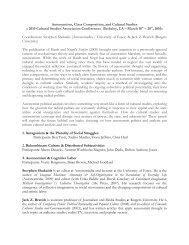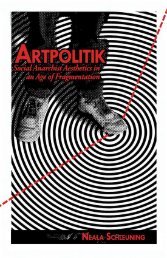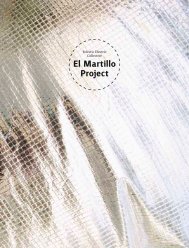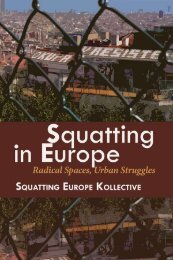extend Foucault’s aesthetic of existence to the hypothesis of a ‘minor biopolitics’,enacted within the margins of a desubjectivation process, as the strategyfor re-establishing a space for becoming through this zone of ‘impersonalpower’ and opacity that constitutes ‘life itself ’.For Agamben, the ‘care of the self ’ should be referred back to a morepromising notion of ‘usage’: analysing, in fact, the etymology of the Greekverb ‘krestai’, he draws the medial and neutral position of ‘use’, as what thatmight render the typically ‘mediated’ nature of an action – that one is at thesame time the agent and the patient of – and therefore in keeping with thedouble becoming that subjectivation means within this nexus.Agamben’s ontology of modalities is echoed in his philosophy of a politicsof potentialities, and goes back to the analyses he develops in Means withoutEnd. 42 It is here that he constructs the sphere of ‘gestures’ as the proper ethicaland political field of ‘pure means’.Gesture, he says, is the suspension of action, the withdrawal of actionupon itself: it unties the knot that binds action to an instrumental end, whilerevealing and exposing our own being-in-a-medium. The impersonality ofgesture is the very condition of its appropriation, of its subjectivation: I becomesubject through (my) gestures.We are not far from somatics’ concerns about the interruption of theaction/perception loop: as diverse as they may be, their methodologies andstrategies attend precisely to the qualitative, modal experience of movement,as the source for potential changes.In this regard, they are technologies of self, but precisely in so far as theyare capable to hold and to care for the tension between subjectivation anddesubjectivation, between ethics and politics, in the knot of an aesthetic ofexistence.If resistance means finding new gestures to displace the diagram of powerrelations that we both enact and endure, we need to reconsider our owncultural categories and perceptual representations, to insinuate doubts in ourcertainties, and to challenge them with the singularity and the contingency ofthe events we are exposed to: it is indeed a time consuming task, like watchingMilestones (more than three hours long), like knitting and unknitting theoryand praxis.Are somatics of some use in all of this? Or are they rather the comfortable‘rehearsals of utopian sensations and relations’?I guess rehearsal time is not exhaustible in one performance.And improvisation is a life-long practice.138
Endnotes1. For the history of somatics, see: Don Hanlon Johnson (ed.) (1995), Bone, Breath and Gesture.Practices of Embodiment. North Atlantic Books: Berkeley CA. In the introduction of his essay,Johnson traces back the origins of somatics to the end of the nineteenth century, throughoutEurope and the US.2. Bonnie Bainbridge Cohen (1942 -), an American therapist, movement artist, researcherand educator, created the School for Body-Mind Centering in 1973.3. bodymindcentering.com/about4. ‘A body image consists of a system of perceptions, attitudes, and beliefs pertaining to one’sown body. In contrast, a body schema is a system of sensory-motor capacities that function withoutawareness or the necessity of perceptual monitoring’, Shaun Gallagher (2005), How the BodyShapes the Mind. Oxford University Press: New York. p. 24. The notion of body image, though, isat the crossroad between phenomenology, psychoanalysis and the neurosciences; its first introduction,in fact, is due to the Viennese psychoanalyst Paul Schilder (The Image and Appearanceof the Human Body, published in 1935).5. Thomas Hanna (1970), Bodies in Revolt. A Primer in Somatic Thinking. Free Person Press:Novato CA. In particular, Hanna writes: ‘Soma does not mean body; it means “Me, the BodilyBeing”. Body has, for me, the connotation of a piece of meat (…). Soma is living; it is expandingand contracting, accommodating and assimilating, drawing in energy and expelling energies’, cit.p. 35. In doing so, ‘Hanna recovered the older Christian mystical use of the term, whose source isin the New Testament. Paul distinguishes between the Greek word sarx, which has a sense of “ahunk of meat”, from soma, which Paul used to designate the luminous body transformed by faith’,J.H. Johnson, ‘Introduction’, op. cit., p. XV6. Thomas Hanna, op. cit., p. 2587. Robert Kramer, John Douglas, ‘Reclaiming our past, reclaiming our beginning’, interviewwith G. Roy Levin, in Jump Cut: A Review of Contemporary Media, n° 10-11, pp. 6-8: ejumpcut.org/archive/onlinessays/JC10-11folder/KramerDouglasIntLevin.html8. Linda Hartley (1989), Wisdom of the Body Moving. An Introduction to Body-Mind Centering.North Atlantic Books : Berkeley CA, p. 189. See: Aline Newton (1995), ‘Basic Concepts in the Theory of Hubert Godard’, in Rolf Line,vol. 23 pp. 32-4310. Kevin Frank (1995), ‘Tonic Function. A Gravity Response Model For Rolfing Structuraland Movement Integration’, in Rolf Line, vol. 23, pp. 12-20. For articles related to Hubert Godard’swork, see: somatics.de11. Proprioception is the sense of the relative position of neighboring parts of the body andstrength of effort being employed in movement. It is distinguished from exteroception, by whichone perceives the outside world, and interoception, by which one perceives pain, hunger, etc.,and the movement of internal organs. Proprioception refers to the integration of several sensorialmodalities concerning body movement in space, its equilibrium and balance: vestibular system,joints receptors, pressure receptors, etc. Although the word kinesthesia is sometimes used interchangeablywith proprioception, kinesthesia is the general sense of body motion.12. Linda Hartley, op. cit., pp. 19-2113. I’m indebted to Mårten Spångberg for pointing this section of Carroll’s poem in his conversationwith Silvia Bottiroli: ‘Fellow Travelers’, in The Swedish Dance History Vol. 4, 201314. Bonnie Bainbridge Cohen (2008 [1993]), Sensing, Feeling and Action. The ExperientialAnatomy of Body-Mind Centering. Contact Editions: Northampton MA, p. 3115. Isabelle Ginot has developed the analysis of the performative regime of somatic discoursesin her article: ‘From Shusterman’s Somaesthetics to a Radical Epistemology of Somatics’, inDance research journal, n°42, University of Illinois Press : Champaign (USA), summer 2010, pp.12-29. Available online at : danse.univ-paris8.fr/chercheur_bibliographie.php?cc_id=4&ch_id=11139
- Page 3 and 4:
nanopoliticshandbookthe nanopolitic
- Page 5 and 6:
IndexpageIntroduction11collective p
- Page 7:
Towards a careful listeningexercise
- Page 10 and 11:
1/2/3/A map of this bookThis book h
- Page 12 and 13:
From bodies to booksTrying to rende
- Page 15:
collectiveprocesses
- Page 19 and 20:
So a second level of our work conce
- Page 21 and 22:
mines our lives, work and politics
- Page 23 and 24:
through other experiences? And how
- Page 25 and 26:
care (not just individual but colle
- Page 27 and 28:
mal and natural that make life ‘e
- Page 30 and 31:
areas are erased by gated shopping
- Page 32 and 33:
Work, professionalization and the p
- Page 34 and 35:
on guidelines and protocols: whethe
- Page 36 and 37:
Endnotes1. This text was collective
- Page 38 and 39:
that we have been wandering these l
- Page 40:
does the common narrative of a grou
- Page 43 and 44:
also audiovisual recordings. We wou
- Page 45 and 46:
How is it that the awareness and lo
- Page 47 and 48:
translate into product. As an a pri
- Page 49 and 50:
and palpable to us on a daily basis
- Page 51 and 52:
en its double meaning in Spanish.
- Page 53 and 54:
Looking again at Bifo’s text, it
- Page 55 and 56:
Micropolitics— David Vercauteren
- Page 57 and 58:
to pursue here, which is that of gr
- Page 59 and 60:
So what are the stakes concerning t
- Page 61 and 62:
In order for a power relation to be
- Page 63 and 64:
7. Félix Guattari (1986), Les ann
- Page 65 and 66:
of our terrain? What do we need (co
- Page 67 and 68:
noyed, fatigue...) in 2-3 words. Th
- Page 69:
methodsandmethodologies
- Page 74 and 75:
activities? Are the quests of a sha
- Page 78 and 79:
present, and the relationship is mo
- Page 80 and 81:
fundamental question of the worksho
- Page 82 and 83:
another, and this confusion also al
- Page 84 and 85:
* * *The production of subjectivity
- Page 86 and 87: Sculpting and modelling seriesAs a
- Page 88 and 89: verbalised - of our experiences and
- Page 90 and 91: exerciseThe machine of rhythmsIn Ap
- Page 93 and 94: Somaan anarchist experiment— Jorg
- Page 95 and 96: Because they want to make omelettes
- Page 97 and 98: Soma games ask a group to interact
- Page 99 and 100: scientifically proven fact today, m
- Page 101 and 102: Endnotes1. Roberto Freire (1990) Am
- Page 103: At the end, the group plays as a wh
- Page 106: architects, planners, councillors,
- Page 109 and 110: There have been so many street trai
- Page 111 and 112: exerciseSmiling at strangers,smelli
- Page 113 and 114: Walk around as if you own the stree
- Page 115 and 116: Fling your flip flop from your foot
- Page 117 and 118: Bodily semblances,temporary dwellin
- Page 119 and 120: in the history of dance, theatre an
- Page 121 and 122: in the leitmotiv of texture and wea
- Page 123 and 124: field of metabolic processes, which
- Page 126 and 127: eathing, as in the previous exercis
- Page 128 and 129: common milieu, a transitional space
- Page 130 and 131: Perhaps it’s the notion itself of
- Page 132 and 133: If the imaginary impregnates sensat
- Page 134 and 135: While we were holding it togetherBu
- Page 138 and 139: 16. Linda Hartley, op. cit., pp. 34
- Page 141: experimentsandexperiences
- Page 144 and 145: Need to find ways of holding that a
- Page 146 and 147: messy, collective voices in movemen
- Page 148 and 149: kids that go back to their families
- Page 150 and 151: We met for our first nanopolitics d
- Page 152 and 153: process rushy events and feelings b
- Page 154 and 155: complete freedom because everybody
- Page 156 and 157: elated fears. ‘This works well if
- Page 158 and 159: We have been waiting for Carla to c
- Page 160 and 161: nano of the relationship between ou
- Page 162 and 163: malleable understandings of geograp
- Page 164 and 165: Reflections before being trainedTo
- Page 166 and 167: The controlled body is constantly c
- Page 168 and 169: the purpose of doing this i know, b
- Page 170 and 171: in single-file: Drawing out ideas f
- Page 172 and 173: production pressure. i am all for p
- Page 174 and 175: All: How did the group experience p
- Page 176 and 177: insurmountable barriers all around
- Page 178 and 179: exerciseBody surfaces and boundarie
- Page 181 and 182: A politics ofnetwork-families?Preca
- Page 183 and 184: ways of relating that run counter t
- Page 185 and 186: How to act in this world, how to ri
- Page 187 and 188:
The importance of the debt economy
- Page 189 and 190:
limitations: to give up the silly p
- Page 191 and 192:
a family, or a somehow older networ
- Page 193 and 194:
10. Interview with Nelly, London, A
- Page 195:
together. Draw a ‘conviviality’
- Page 198 and 199:
are less precarious than us. Capita
- Page 200 and 201:
Rather than a vocabulary of politic
- Page 202 and 203:
odies - we must develop our common
- Page 204:
of this as the general condition wh
- Page 207 and 208:
the individual as homo economicus,
- Page 209 and 210:
esistances of individual bodies des
- Page 211 and 212:
happens by way of a new externalisa
- Page 213 and 214:
If we look for a slogan that can de
- Page 215 and 216:
Endnotes1. Precarias a la Deriva.
- Page 217 and 218:
and the Permanence of Primitive Acc
- Page 219 and 220:
exerciseAn exercise indeproletarian
- Page 221 and 222:
No time for the sad passions— Ami
- Page 223 and 224:
men and things seem set in sparklin
- Page 225 and 226:
that radicality (the radicals playi
- Page 227 and 228:
merely reflect action received from
- Page 229 and 230:
to capture value, or the autonomy o
- Page 231 and 232:
Endnotes1. Francois Dosse (2010), G
- Page 233 and 234:
Towards a careful listening— Anja
- Page 235 and 236:
privilege that underlie our speech.
- Page 237 and 238:
consensus based to saturation-based
- Page 239 and 240:
easy reception of linguistic conten
- Page 241 and 242:
It is apparent that the refusal to
- Page 243 and 244:
materiality and characteristics, th
- Page 245 and 246:
tralian.com.au/national-affairs/mea
- Page 247:
ecologiesandmetabolisms
- Page 250 and 251:
Water it a bit. 3Water regularly, d
- Page 253:
Voku Pocu:making a people’s kitch
- Page 257 and 258:
People’s kitchens have a strong l
- Page 259 and 260:
Polenta cakes for friends andcomrad
- Page 261:
mix it with maple syrup. This is pr
- Page 265 and 266:
ResourcesIn this section we collate
- Page 267 and 268:
Campo Grupal, Buenos Aires (AR). Un
- Page 269 and 270:
Caring labour, an extensive archive
- Page 271 and 272:
Silvia Gil (2011) ‘Vidas precaria
- Page 273 and 274:
Freaksexual blog, good on sexuality
- Page 275 and 276:
Biographies:the nanopolitics group
- Page 277 and 278:
he is researching the recent histor
- Page 279:
mara ferreri has worked and studied
- Page 282:
Minor CompositionsOther titles in t










